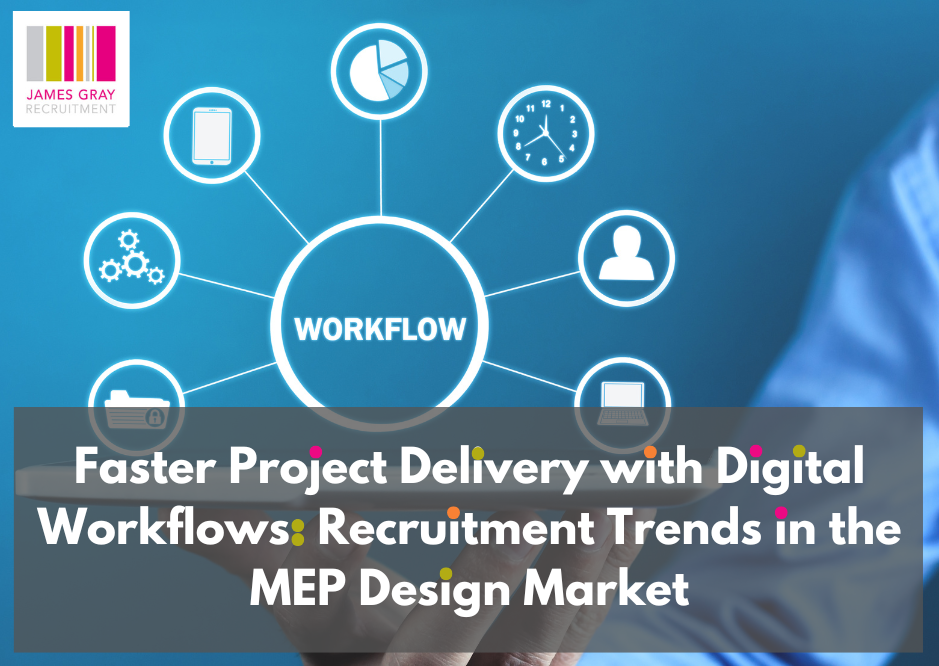
Faster Project Delivery with Digital Workflows
The Mechanical, Electrical, and Plumbing (MEP) design industry is undergoing a rapid digital transformation. As companies increasingly adopt cloud-based collaboration platforms, AI-powered drafting tools, and automated quality control systems, project delivery is becoming faster and more efficient. These digital workflows not only improve design accuracy and reduce errors but also drive a fundamental shift in the recruitment landscape. Both employers and candidates are having to adapt quickly to meet the new demands of a more technologically advanced workflow.
Digital Tools Speeding Up Delivery
The use of cloud-based collaboration tools has significantly accelerated the way MEP engineers work. Platforms like Autodesk BIM 360, Revit, and Trimble Connect enable real-time model sharing and communication between distributed teams. According to the National Institute of Building Sciences, digital tool adoption in the AEC sector has cut project delays by 25% and reduced unnecessary costs by nearly 15%.
As a result, employers are now prioritizing professionals with experience in cloud collaboration, as real-time updates and cross-discipline coordination are critical to staying on schedule and minimizing rework.
AI-Driven Drafting Enhancing Design Precision
AI-powered drafting software is quickly becoming a staple in MEP design workflows. These tools can detect system clashes early, automate routine layout decisions, and recommend design optimizations. For example, AI can generate efficient ductwork paths or electrical layouts that comply with spatial and regulatory constraints—tasks that previously took hours of manual work.
Reports suggest that the integration of AI into Building Information Modeling (BIM) workflows reduces the need for design revisions and clash resolutions by up to 30%, significantly streamlining the design cycle. As this trend grows, candidates with familiarity in AI-enhanced platforms and model validation tools are increasingly in demand.
Automated Quality Control Reducing Risk
Automated quality control checks ensure designs are compliant with building codes and internal standards before hitting the construction phase. These systems flag inconsistencies, omissions, and errors that may otherwise lead to costly change orders later in the process.
Industry data shows that such systems can reduce planning amendments by 10% and lower the number of revisions to original drawings by around 4%. In turn, organizations seek talent that understands not only the principles of MEP engineering but also how to work within digitally governed quality assurance frameworks.
Evolving Hiring Priorities
As these technologies become standard, employers in the MEP design market are shifting their hiring priorities. There is growing demand for professionals who can confidently navigate BIM platforms, utilize AI-driven tools, and contribute to cloud-based workflows. This shift has led to a noticeable rise in hybrid roles that require both technical engineering knowledge and digital fluency.
Recruitment agencies and internal HR teams are now tasked with sourcing candidates who blend traditional MEP expertise with modern software competencies. Engineers with certifications in BIM software, or those who have contributed to projects using automated workflows, are seeing stronger career prospects and salary offers.
Market Outlook
The digital transformation in the MEP sector is set to continue accelerating. According to Verified Market Reports, the global market for cloud construction software is projected to grow by over 13% CAGR between 2024 and 2029. This expansion will further fuel the need for tech-savvy engineers capable of operating in fast-paced, digitally enabled environments.
Conclusion
Digital workflows are reshaping how MEP projects are designed and delivered. Cloud-based platforms, AI-driven drafting, and automated quality control systems are no longer optional—they are essential. These changes are also driving a shift in recruitment trends. Employers are seeking multi-skilled professionals who can combine technical excellence with digital agility, while candidates are increasingly upskilling to remain competitive in a fast-evolving market.
Staying ahead in this new era requires not only investment in technology but also in talent that can use it effectively. The future of MEP design is digital—and those who embrace it will lead the way.

